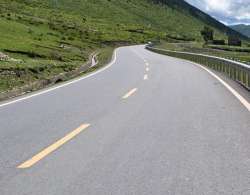Modi govt’s Rs 6.9L cr highways push: Border connectivity to improving mobility, 10 things you need to know about the programme
The programme includes the Bharatmala scheme, under which 34,800 km of highways would be constructed at the cost of Rs 5.35 lakh crore.

In the country’s biggest ever push for highway development and expansion, the Union Cabinet on Tuesday approved a proposal to develop 83,000 km of roads at an investment of Rs 6.9 lakh crore in the next five years.
The plan includes the new 28,400 km Bharatmala highway programme connecting border areas of the country. The plan is focused at improving speed of traffic flow on key corridors by providing uniform four-lane roads between two identified points. Most of these corridors will be shorter and access-controlled for faster movement of cargo vehicles.
Crucially, the announcement comes just days ahead of the Assembly polls in two states. With the infrastructure push, the government has sought to counter allegations of failure to create jobs and also signal its recognition and intent of reviving the economy.
In 10 points, here is what you need to know about the government’s Rs 6.9 lakh crore mega highways push:
- The government on Tuesday approved a package of Rs 6.9 lakh crore to build approximately 83,000 km of highways by 2022.
- The programme includes the Bharatmala scheme, under which 34,800 km of highways would be constructed at the cost of Rs 5.35 lakh crore, Finance Secretary Ashok Lavasa said. Under Bharatmala, the Road Transport and Highways ministry will construct 9,000 km of economic corridors across the country.
- The project also entails constructing 6,000 km long inter corridor and feeder routes, 2,000 km of border and international connectivity roads, 5,000 km to be upgraded under the national corridor efficiency programme, 800 km of greenfield expressways, 10,000 km under the national highway development programme and 2,000 km of coastal and port connectivity roads.
- The government will fund Bharatmala project through market borrowings, central road funds, monetising government-owned road assets, and budgetary allocationBharatmala project through market borrowings, central road funds, monetising government-owned road assets, and budgetary allocation. "For the highway construction programme, Rs 2.09 lakh will come from market borrowing, Rs 1.06 lakh crore is expected to come through private investment and Rs 2.19 lakh crore will come from the central road fund and through toll operate transfer model," Lavasa said.
- In addition to 34,800 km under Bharatmala, National Highways Authority of India (NHAI) will parallel implement the balance works of 48,877 km roads under other current schemes with an outlay of Rs 1.57 lakh crore, Lavasa said. This will be financed by providing Rs 97,000 crore from CRF and Rs 59,000 crore as gross budgetary support.
- Additionally, central and state governments would spend another Rs 88,185 crore in the next three years towards constructing rural roads under Pradhan Mantri Gram Sadak Yojana. The government has also sanctioned almost Rs 11,000 crore towards the development of roads in states with left wing extremism.
- The government aims to build 10,000 km of roads annually under this highway development programme, and expects the construction and related activities to create 14 crore mandays of jobs.
- The programme will focus on reducing the travel time for logistics and reducing costs. The government will try to improve mobility through better road networks and rolling out of smart-tag based tolling.
- The government’s latest push is expected to significantly increase the average distance a truck in India covers daily. As per current estimates, poor road conditions, narrow width and congestions ensure that a truck covers an average of 250-300 km daily in comparison to 700-800 km in developed countries.
- The National Highways Authority of India has already prepared detailed project reports (DPRs) for about 10,000 km of the identified network, which will help faster roll out of projects.